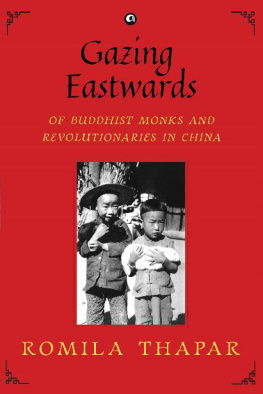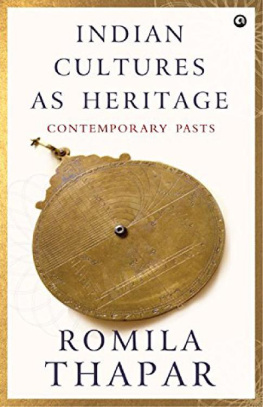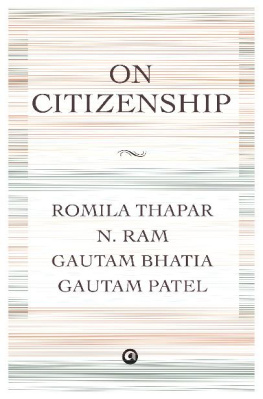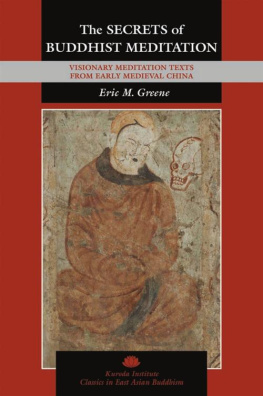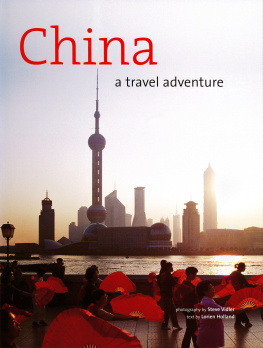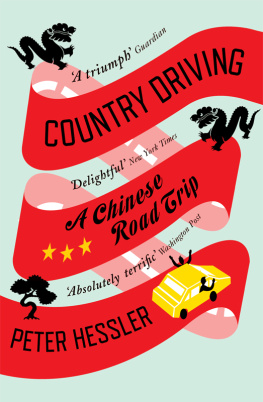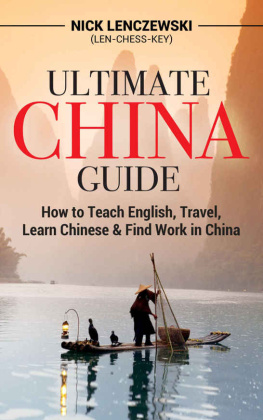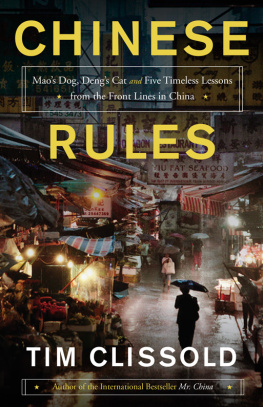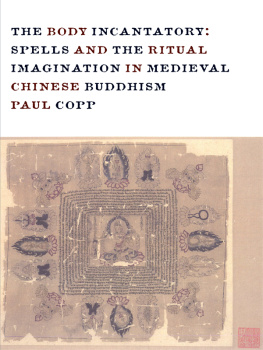Also by Romila Thapar in Aleph Book Company
Anthologies:
Which Of Us Are Aryans?: Rethinking the Concept of Our Origins
On Nationalism
The Public Intellectual in India
Books:
Indian Cultures as Heritage: Contemporary Pasts
The Past As Present: Forging Contemporary Identities Through History
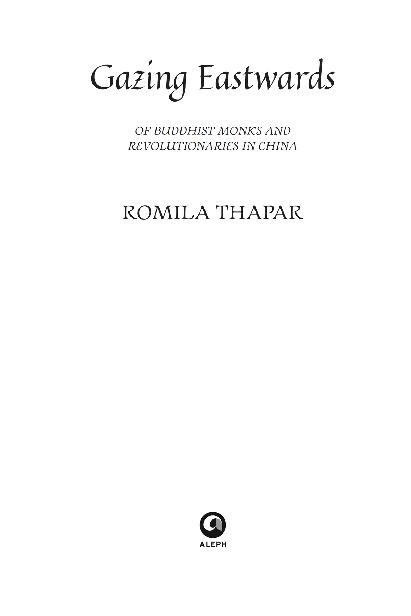
ALEPH BOOK COMPANY
An independent publishing firm
promoted by Rupa Publications India
First published in India in 2020 by
Aleph Book Company
7/16 Ansari Road, Daryaganj
New Delhi 110 002
Copyright Romila Thapar 2020
All rights reserved.
The author has asserted her moral rights.
The views and opinions expressed in this book are those of the author and the facts are as reported by her, which have been verified to the extent possible, and the publisher is not in any way liable for the same.
Back cover image: pngtree.com
The publisher has used its best endeavours to ensure that URLs for external websites referred to in this book are correct and active at the time of going to press. However, the publisher has no responsibility for the websites and can make no guarantee that a site will remain live or that the content is or will remain appropriate.
No part of this publication may be reproduced, transmitted, or stored in a retrieval system, in any form or by any means, without permission in writing from Aleph Book Company.
ISBN: 978-93-89836-06-6
This book is sold subject to the condition that it shall not, by way of trade or otherwise, be lent, resold, hired out, or otherwise circulated without the publishers prior consent in any form of binding or cover other than that in which it is published.
Romila Thapar at the entrance to a cave at the site of Maijishan.
[ Photograph taken by Dominique Darbois and given to Romila Thapar as a memento of the visit to China in 1957. From the archives of the author .]
CONTENTS
List of Maps
AUTHORS NOTE
Our visit in 1957 into Chinas past, the subject of this account, was made possible by an invitation from the Society for Cultural Relations with Foreign Countries, of the Peoples Republic of China. I would like to thank the Society not only for its hospitality during the period we were there, but also for its helpful assistance in our research at both the sites where we worked. We arrived in China taking flights from Paris to Prague to Moscow to Beijing. We travelled in China from Beijing to Xian where initially the route went through Hebei province with its loess plateau to the west and cultivated land to the east. The journey was largely north-south and at one point we turned west and entered the valley of the Huang He just before the river turns north. This took us into Shaanxi province and to Xian. We then moved up to Lanzhou after which we went into the Wei Valley that took us to Maijishan. At the end of our stay in Maijishan, we resumed our itinerary to the north-west. The onward journey from there took us again along the plateau at the southern end of the Gansu corridor. We travelled in the shadow of the Qilianshan on one side and the edge of the Gobi Desert on the other. We flew from Lanzhou to Su Zhou and then travelled by jeep to Dunhuang. On our return from Dunhuang we took a slightly different route and drove through Yumen. We took the train to Nanjing, Shanghai, and Hangzhou before returning to Beijing. Our final departure from Beijing was a flight to Canton from where we went to Hong Kong.
My special thanks go to Xinru Liu for her meticulous reading of the text, and the occasional correction where necessary, especially of transliterations from the Chinese. For those who read the manuscript and made comments and suggestions, and urged me to publish it, my grateful thanks. These included Shiv Shankar Menon, Deepak Nayyar, Romi Khosla, Naveen Kishore, and Valmik Thapar. Deborah Klimburg-Slaters comments on the Introduction were very helpful. Sreedeep Bhattacharya spent much time and effort in digitizing the photographs and helping me sort them out, as did Valmik Thapar and Sunandini Bhattacharya. The photographs are my amateurish attempts to capture something of our journey in visual form. Naina Dayal and Kanad Sinha gallantly carried two hefty volumes on Dunhuang to Delhi from Dunhuang. These recently published volumes were very useful in providing coverage of the sites in Central Asia. Burzine Waghmar was as always unfailingly helpful with getting me copies of the articles which I did not have access to in Delhi.
I was delighted when David Davidar and Aienla Ozukum agreed to publish the book. My hesitation was that as a travelogue its appeal would be limitedbut with their editing it should be in hopeful shape.
Both Xinru Liu and Mingo Wong, in their different ways, made me aware of a contemporary China as well as a Chinese past that was new to me. This book is for them.
Romila Thapar
January 2020
New Delhi
PREFACE
On rummaging through a box full of old papers I came across a diary that I had kept largely for my own entertainment, and that of close friends, when I visited China in 1957. I had virtually forgotten about it. But on rereading it, I wondered whether it was worth publishing as these were observations on being in China sixty-two years ago. I would like to emphasize that this narrative and description refer to a time period of more than half a century agoa fact that the reader must keep in mind. It was a visit that enabled me to understand some aspects of another civilization comparable to mine and not unconnected, and about which I knew so little. It was also to experience the early stages of the revolution in China. Reading the diary was a way of recalling a historical moment as I experienced it. I thought it might be of interest as a memoir of a time and condition that no longer exist. Let me emphasize that this is neither an analytical study of, nor a commentary on, the China of 1957. Its publication is an attempt to recall a viewing of a few historical events as witnessed in a moment of time. And for me it is an entirely new way of looking at the past, quite different from my usual historical studies. The perspective, however, was not unconnected with my general interest in early periods of history.
This text therefore is a brief account of a period spent in China in 1957, from July to October, working mainly at two Buddhist cave sites and monasteries, working on their murals and sculpture; and spending a little further time at the major museums in Beijing, Xian, Nanjing, Shanghai, and a few other places, focusing on objects of the same period as the murals in the cave sites. I went as a research assistant to Anil de Silvaan art historian from Sri Lanka. The two sites were Maijishan (earlier known as Maichisan), and Dunhuang (earlier known as Tun Huang). The transliteration of Chinese words into the Roman script has changed from when we were there. The words now use a system called Pinyin. I have tried as far as possible to initially give the old spelling and then keep to the new spelling.

